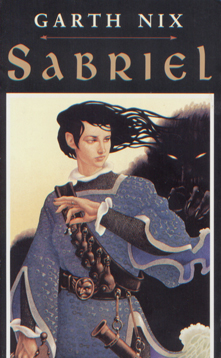Magical schoolgirls, zombies and talking cats
 CREDIT: LEO AND DIANE DILLON (COVER), HARPERCOLLINS (PUBLISHER)
CREDIT: LEO AND DIANE DILLON (COVER), HARPERCOLLINS (PUBLISHER)Sabriel is one of the most understated super heroines in literature.
The ‘90s was the era of the female superhero, when Xena: Warrior Princess, Buffy the Vampire Slayer, Sailor Moon, the Powerpuff Girls, Dana Scully, the Pink and Yellow Power Rangers and countless other butt-kicking women punched their way into our hearts. These groundbreaking heroines were widely embraced, but there is still one particular girl whose name remains unsung.
Published in 1995, is the first instalment of Australian author Garth Nix’s Old Kingdom Trilogy. Despite winning the Aurealis Award that year for the country’s best young adult and fantasy novel, along with finding a place on the American Library Association Notable list, the series has only managed to garner a modest fan following in North America. This needs to be remedied immediately.
To the south of the mystical Old Kingdom lies the modernized land of Ancelstierre. It is here that the black-haired teenager Sabriel boards at the all-girls Wyverly College, where she comes first in English and Music, third in Mathematics, seventh in Science, second in Fighting Arts and fourth in Etiquette.
She is also first in Magic, but the subject is not an official part of the school’s curriculum and only taught underhandedly to students with their parents’ express permission. In Sabriel’s family, magic must be learned. Her father is the Abhorsen, Ancelstierre’s appointed necromancer. In accordance to family tradition, he is responsible for protecting the land from the living dead.
The plot is set into motion when Sabriel receives a message from her father, who has been trapped beyond the gates of Death by the Old Kingdom necromancer, Kerrigor.
Armed with a set of magical bells and aided by her father’s feisty feline servant, Moggot, the time has come for Sabriel to take her place as Abhorsen and stop Kerrigor from unleashing legions of zombies.
Sabriel aligns itself with a few known elements of the literary epic. It places its heroine in a richly detailed fantasy setting and surrounds her with supernatural forces that she both wields and fights against. But Sabriel herself deviates from the typical epic hero who effortlessly masters everything he does.
Like many of us, Sabriel is skilled in some things but not all, and contends not only with overwhelming evils but also her own self-doubt. The action-packed story is littered with humorous interludes where she embarrasses herself by misinterpreting obvious situations. Other scenes show her freezing with the fear of letting down her father and failing to live up to his reputation.
While I’m doubtful any of us have been expected to save the world from the walking dead, we can probably all relate to the terrors of taking on our first major career roles. At its core, Sabriel is a coming- of-age novel, telling the story of a young woman transitioning from the safety of her school to the wilderness of the working world.
The book is highly readable and appeals to a wide range of audiences. It is sophisticated, playful and incredibly imaginative. Fantasy lovers seeking an escape and perhaps some encouragement at the end of this semester need look no further than Sabriel, which has been patiently waiting for more than 20 years. I couldn’t think of a better time to pick it up.














